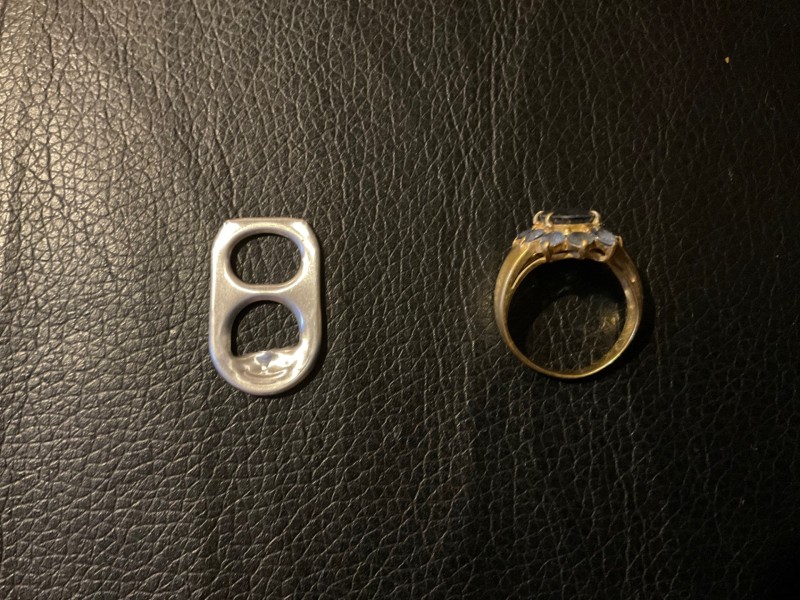-
Posts
177 -
Joined
-
Last visited
Content Type
Forums
Detector Prospector Home
Detector Database
Downloads
Posts posted by mcjtom
-
-
Would my understanding of this be correct then: if pushing the coil towards the ground produces signal, it means that the GB value is set too high for this ground (on Fisher's scale) and too low on Minelab's scale (and when pulling the coil up, the reverse is true)?
-
It looks like this may be the answer as in 'yes', if Minelab uses similar metaphor:
-
8 hours ago, GB_Amateur said:On 2/2/2022 at 6:50 AM, mcjtom said:
JB Weld original. It is detectable if the bead is large enough.
I made a 1.23 g bead
That's probably close in size to a sphere 11 mm in diameter? - JB Weld density is some 1.93 g/cm^3 (from MSDS).
-
Tom Dankowski seems to suggest that any metal near the coil can disturb the balanced magnetic field around it and create blind spots even if not moving wrt the coil. But then the cable connecting the coil with the control box should influence it too. Maybe the mas of metal wires in it is not significant enough or perhaps being off centre makes it less influential?
Anyhow, it looks like one may be better of using an epoxy without steel filling when working around the coil, just in case...
I guess the question is: is it worth to reinforcing the ears at all - do they really break off easily? One reason I have for it is that I remove coil from the shaft to make the machine more compact and be able to fit the parts in a duffle bag I use on the motorcycle - so maybe it makes sense to make it stronger before it's too late?
-
The Vanquish evidently does something useful with sorting out the changing ground signal strength and type (at least on the beach). A question for those that used both machines: does it behave as if the ground balance was fixed (e.g. similar to zero in Beach 1 mode on the Nox) or more as if there was a Tracking ground balance in action?
-
16 hours ago, Steve Herschbach said:
there is zero incentive for them to undermine sales of upcoming new models by constantly updating old hardware.
In the photography world, Fujifilm got itself a lot of fans and good will (and thus sales I imagine) by promoting Kaizen - updating firmware of cameras long discontinued and replaced with newer models. Fuji X-E2 is a great example - the last firmware update made it into a totally different and better camera. Fuji didn't have to do it.
-
14 hours ago, alan46 said:
Hi, I think of buying the Quest Scuba Tector Pro
A bit off topic of building coils, but I was thinking of buying this detector vs. Nokta Pulsedive for snorkeling and light diving. Have anybody tried both and could offer some comments on what to expect and which one would be a better idea?
-
The coil is Vanquish 10x7". JB Weld original. It is detectable if the bead is large enough.
-
I was considering reinforcing the coil ears with some fiberglass and epoxy (on the outside). Two questions:
a) does it make sense to do that at all?
b) I'm partial to JB Weld for the epoxy part, which is non-conductive (the steel powder is fine and the particles isolated by the epoxy matrix), but it is relatively ferromagnetic. Even though the ears don't move with respect to the coil, would it have a potential of disturbing the magnetic field so close to the coil, as I understand some metal lower rods and bolts did in older detectors designs?
-
Given that Vanquish has been described as a simplified Nox, and that its settings (fixed or somewhat adjustable) can be approximately related to those on the Nox (e.g. the overall mode probably similar to Beach 1, high iron balance likely about 8, three different recovery speeds within recovery speed range on the Nox - but I'm not sure where), could someone comment on what ground balance mode on the Nox resembles what the Vanquish may have been set to do in this department?
-
On 1/18/2022 at 11:50 PM, Steve Herschbach said:
this software is immensely flexible
What platform does the forums use?
-
On 9/7/2020 at 2:21 AM, Steve Herschbach said:
is Iron Bias reducing the non-ferrous false signals, or increasing the ferrous signal?
Was that resolved? I have no idea, but something tells me that at high iron-bias the the non-ferrous signal is replaced by the ferrous one, if below threshold...
-
On 1/11/2022 at 9:20 PM, Skullgolddiver said:
those finds are usually not "friends".
Does it mean that if I’m finding lots of pull tabs on a beach I should be happy that the machine works, but I’m in the wrong spot, more or less? 🙂
-
9 hours ago, Joe Beechnut OBN said:
I would say 80% of the gold I do dig is deep..in the 14 to 16 inch range.
To recover such deep targets from wet sand, are you using a scoop, and if so a big or a small one? I'm set on a small, round, SS scoop, but I can only imagine how useful it may be on the wet beach...
-
14 hours ago, GB_Amateur said:
What I've never seen is a similar plot for copper-silver alloys. You wouldn't happen to have that one?
Not a plot and a random source, but it seems that adding copper to silver lowers the conductivity of the alloy in similar fashion to gold-silver/copper alloys, below the conductivity of either pure metal.
-
CooB has an interesting 'beach shovel'. Would anyone have any experience using it (or something like it) on the beach (or elsewhere)?

-
Many thanks for all these!
What would be the minimum useful thickness of a stainless steel plate (excluding rod socket reinforcement) of which the scoop is made? Would 1.5 mm be the magic number, balancing the weight and sturdiness?
-
I got myself a cheap poly-carbonate sand scoop. It's kind of sturdy, but I already found that it doesn't work particularly well, especially in wet sand, for at least three reasons: it's not as sturdy as stainless steel and digging the gravel is not easy, the holes are not big enough for the wet sand to fall through easily (I think I need a mesh at the bottom somehow), and, for compactness, my scoop doesn't have a long handle, which makes it pretty difficult to dig quickly and often...
I was hoping that somebody could point me out to a better scoop that I could either buy online (Amazon, Lazada - the latter is better as there are no import duties in Thailand) or that could inspire me to ask someone here to make for me. The ideal one would be:
- small in size
- with the mesh that allows the wet sand to fall through (but, which would also allow or the scoop to be pushed into the sand with one's foot)
- with a longer handle, possibly removable (but not the full length as it won't be portable enough the way I do it - motorcycling...)
- cheap... (I know, but one has to start somewhere...).
Cheers!
-
-
This has been said many times, but there is nothing like seeing it. I can’t tell the difference between those particular two, in any orientation, either by sound or ID (on Vanquish 440). Are there any tricks of the trade to increase the chance of differentiating the right-size gold ring from a modern beer can pull tab?
-
Cheers for that! The question was really about the particular choice of Minelab's default notching in the Custom mode, not how to change it. I think I might have figured out the answer: the notching-in corresponds to all modern US (but not Australian) coins with the nickel at around 13 and the rest at 21+.
-
There is an interesting factory preset for custom mode: based on Coin mode with its fast recovery time and low/medium tone break at ID 2/3 but only ID 11-13 and 21-40 ranges notched in. What may be the intended purpose of it?
-
Col Dan's 3 tone setup is similar to the fixed one on Vanquish 440. There, the mid tone goes up to ID 17 with high tone starting at 18. What is the logic behind choosing this particular breakpoint between mid and high tones?
-
Kind of vaguely related to the sound questions above: I found a 'target' in dryish ocean white beach sand. ID 17/18, round, solid signal from all directions. It was a paint can lid (some 20 cm in diameter, ferrous, perfectly horizontal, a little rusty, but it was some 50 cm (20 in) deep! Good lesson.




What Do The Ground Balance Numbers Mean?
in Minelab Equinox Forum
Posted
Would at least these general statements be roughly correct?
Whether measuring the response phase change in a single frequency or comparing the responses in different frequencies in MF (and also disregarding how such GB scale and its 'zero' or default are implemented in a particular detector), the ground balance objective is to filter out (ignore) the slow-changing responses caused by moving the coil over the ground minerals devoid of valid, smaller/weaker, targets.
Rather than targeting all slow-changing signals, the filter tries to decrease only those on the ferrous-conductive 'ID' scale that the particular mixture of minerals in the ground is likely to produce (i.e. preventing unnecessary removal of slow-changing signals in the range outside of the minerals-mixture), but it needs to be shown (set to) what range it should be.
Pumping (or even sweeping) the coil over given soil simulates such slow-changing responses and allows the machine to detect the ferrous/conductive nature of the signal due to the ground in order to subsequently aim the filter (automatically or manually) at the most consequential slow-changing signal range to be decreased by the filter and thus best quiet the machine on this ground type.
If the ground signal increases when moving the coil towards the ground, the machine GB (the particular range of 'IDs' for slow-changing signals set to be filtered) is off and the filter range is incorrectly set too much towards removing slow-changing ground signals in the ferrous range, best represented by magnetite (at the expense of insufficiently filtering the true ground response which may be in the more conductive range, i.e. towards the salt).
If the coil 'sings' when being moved away from the ground, it indicates that the machine GB is also not set optimally, but this time it is trying to filter the higher conductive range (closer to salt) whereas the actual soil response may be in the magnetite range and remain unfiltered (thus producing the false signal caused by spacial changes in soil composition or changing the coil-to-ground distance).